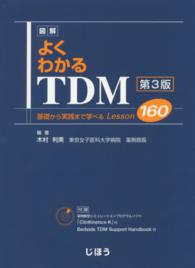- ホーム
- > 洋書
- > 英文書
- > Nature / Ecology
基本説明
サメ類の生態、淡水・海水への生理学的適応、環境汚染などによる生態系の変化と保全に関する情報を集約。2004年出版の前作刊行以降の変化を受け、最新情報を追加。
Discusses: Unique patterns of biogeography and biodiversity; Physiological adaptations that make them particularly well suited for both oceanic and freshwater realms. Population challenges due to human interaction and anthropogenic effects.
Full Description
Expanding the coverage of its preceding volume (2004), this new book considers how elasmobranch fishes, the sharks, skates, rays, and chimaeras' successfully survive in the wide range of habitats in which they live. It examines the particular suitability of integrated sensory systems and the resultant perception of their surroundings. This resource also discusses the stresses and behaviors that prevent elasmobranchs from inhabiting some oceanic realms and the adaptations that allow many other elasmobranch species to exploit virtually all aquatic realms, from marine and freshwater habitats, to tropical and Arctic waters.
Contents
Chondrichthyan Biodiversity: Ecosystems and Distribution of Fauna: Epipelagic Oceanic Elasmobranchs. Deepwater Chondrichthyans. Chondrichthyans of High Latitude Seas. Elasmobranchs of Tropical Marine Ecosystems. Biology of the South American Potamotrygonid Stingrays. Life History Strategies of Batoids. Adaptive Physiology: Ontogenetic Shifts in Movements and Habitat Use. Tracking and Analysis Techniques for Understanding Free-Ranging Shark Movements and Behavior. Sensory Adaptations to the Environment: Electroreceptors as a Case Study. Molecular Insights into Elasmobranch Reproductive Behavior for Conservation and Management. Physiological Responses to Stress in Sharks. Pollutant Exposure and Effects in Sharks and Their Relatives. Conservation: Factors Contributing to Shark Attacks on Humans: A Volusia County, Florida, Case Study. Shark Control: Methods, Efficacy, and Ecological Impact. DNA Forensic Applications in Shark Management and Conservation. Unraveling the Ecological Importance of Elasmobranchs. Life Histories, Population Dynamics, and Extinction Risks in Chondrichthyans.








